(完整word版)惠特曼 自我之歌分析
- 格式:doc
- 大小:24.50 KB
- 文档页数:3

song of myself6诗歌鉴赏在美国诗人惠特曼的众多作品中,《自我之歌》(Song of Myself)堪称是其最具代表性的一首。
这首诗歌创作于1855年,收录在诗人的第一本诗集《草叶集》(Leaves of Grass)中。
作为一首具有划时代意义的诗歌,它不仅展示了惠特曼独特的创作风格,还表达了他对自由、民主、人性等主题的深入思考。
诗歌主题及风格特点:《自我之歌》以第一人称视角展开,通过诗人对自己的描绘,展现出一个追求自由、独立的个体形象。
诗人以草叶为象征,寓意着生命的活力与无穷力量。
整首诗歌风格独特,语言质朴、直接,充满激情。
诗人运用了大量比喻、象征等修辞手法,使得诗歌具有丰富的内涵和强烈的表现力。
诗歌结构及韵律分析:《自我之歌》共分为五个部分,每个部分都有不同的主题和情感。
诗歌在结构上呈现出一种阶梯式上升的趋势,从对自我的认识逐渐拓展到对自然、社会和人类的关注。
在韵律方面,诗人采用了自由体形式,打破了传统的五言七律,使得诗歌更加贴近口语,富有亲和力。
重点词句解读:在诗歌中,诗人多次提到“草叶”,它象征着生命的活力与创造力。
此外,诗中还有诸多对自然景物的描绘,如“海浪”、“微风”等,这些意象均体现了诗人对自由、独立的追求。
此外,诗歌中还有一些具有哲理性的句子,如“我从不去想我所无法理解的,我只是生活在我自己的时代”,这表达了诗人对现实生活的关注和对未知领域的探索。
诗歌鉴赏启示与建议:通过对《自我之歌》的鉴赏,我们可以领略到惠特曼独特的诗歌风格和深刻的思想内涵。
在学习这首诗歌时,我们建议读者从以下几个方面入手:一是了解诗歌背景和作者生平,以更好地把握诗歌主题;二是分析诗歌结构、韵律和修辞手法,领略诗歌的艺术魅力;三是深入解读重点词句,理解诗歌背后的哲理。
通过这些方法,我们将能更好地欣赏到《自我之歌》的无穷魅力。
综上所述,《自我之歌》是一部具有深刻内涵和独特风格的诗歌佳作。
它不仅展示了诗人对自由、独立的追求,还为我们提供了一种全新的审美体验。
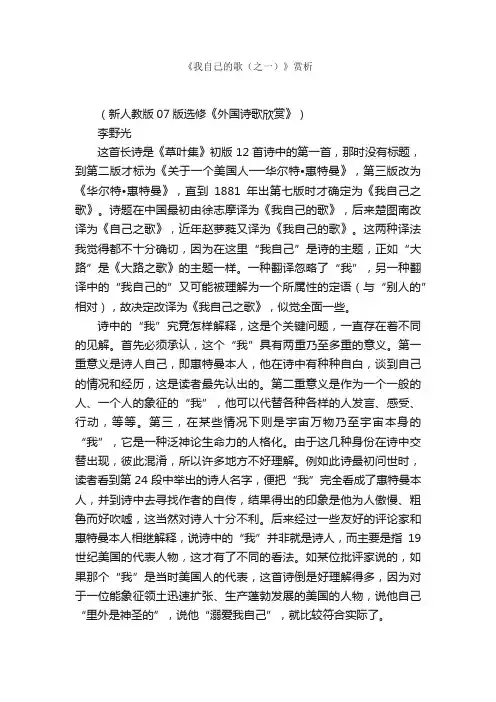
《我自己的歌(之一)》赏析(新人教版07版选修《外国诗歌欣赏》)李野光这首长诗是《草叶集》初版12首诗中的第一首,那时没有标题,到第二版才标为《关于一个美国人──华尔特•惠特曼》,第三版改为《华尔特•惠特曼》,直到1881年出第七版时才确定为《我自己之歌》。
诗题在中国最初由徐志摩译为《我自己的歌》,后来楚图南改译为《自己之歌》,近年赵萝蕤又译为《我自己的歌》。
这两种译法我觉得都不十分确切,因为在这里“我自己”是诗的主题,正如“大路”是《大路之歌》的主题一样。
一种翻译忽略了“我”,另一种翻译中的“我自己的”又可能被理解为一个所属性的定语(与“别人的”相对),故决定改译为《我自己之歌》,似觉全面一些。
诗中的“我”究竟怎样解释,这是个关键问题,一直存在着不同的见解。
首先必须承认,这个“我”具有两重乃至多重的意义。
第一重意义是诗人自己,即惠特曼本人,他在诗中有种种自白,谈到自己的情况和经历,这是读者最先认出的。
第二重意义是作为一个一般的人、一个人的象征的“我”,他可以代替各种各样的人发言、感受、行动,等等。
第三,在某些情况下则是宇宙万物乃至宇宙本身的“我”,它是一种泛神论生命力的人格化。
由于这几种身份在诗中交替出现,彼此混淆,所以许多地方不好理解。
例如此诗最初问世时,读者看到第24段中举出的诗人名字,便把“我”完全看成了惠特曼本人,并到诗中去寻找作者的自传,结果得出的印象是他为人傲慢、粗鲁而好吹嘘,这当然对诗人十分不利。
后来经过一些友好的评论家和惠特曼本人相继解释,说诗中的“我”并非就是诗人,而主要是指19世纪美国的代表人物,这才有了不同的看法。
如某位批评家说的,如果那个“我”是当时美国人的代表,这首诗倒是好理解得多,因为对于一位能象征领土迅速扩张、生产蓬勃发展的美国的人物,说他自己“里外是神圣的”,说他“溺爱我自己”,就比较符合实际了。
《我自己之歌》作为惠特曼的代表作,作为《草叶集》的缩影,它的产生背景就是《草叶集》的背景,其主题思想也就是《草叶集》的中心思想。

Song of myself (The Yankee…to her feet)1.令狐文艳2.The theme of the poemIn this part, atfirst, the poet catches a beautiful scene of a “Yankee clipper”, and then interrupted by boatman to go and “have a good time” around“chowder-kettle”. Atlast, people’s happiness, casualty and beauty in a wedding is vividly described. Based on the context and our group discussion, we believe the theme of this poem lies in its positive attitude towards life and appreciation life’s beauty.3.The poet’s attitude and feeling and oursAfter the group talk we agree that the poem is in a happy ,joyous and leisuremood, andthe poet is full of passion and happiness in terms of human life and harmonious relationships.We are impressed by the poet’s active and passionate attitude. The word “sparkle and scud” jump into our eyes, by which we almost hear the crisp cut sound and see the shinning of the scissors. These two words make this line alive by offering us a sensible picture.4.Social referencewe think this poem mainly based on Whitman’s own experience in the wild vast West frontier of America. From this poem’s contest it’s not hard to find that Whitman’s witness of the free and casual way of people’s life contributed to this poem.nguageThis poem is written in bank verse, the unique form of Whitman’s poem. It’s free form pulsingthe plain words make this poem easy to understand. Whitman also employs a factual tone, astraight forward way when he describes the “Yankee clipper”, theparty, and people who are going to have a wedding.I heard a fly buzz---when I die---1. Theme of the poemThe poet described what I’ll go through “when Idie”. The poet “heard a fly buzz”, wondering she is seeing God, flashing back what she had been through and gradually dying.2. Attitude and feelingIn term of facing death, thepoet stays sober and calm and treats death as something trivial. A still and silentenvironment is created .we can feel this from“hear a buzz” and“breaths were gathering firm”. The poet dies without any company suggestinga lonely atmosphere.The line“The Eyes around---had wrung them dry ---And Breaths were gathering firm”impress me the most. Itgives me detailed description on the poet’s death slowly and surely. The process from live to death seems being stretched, which made me terrified and sad in a way.3 RhythmThis poem has 4 stanzas and each stanza has 4 lines. The rhyme scheme is A BCB, with trimester and tetrameter iambic lines.4 languageThe poem is written in unique Emily Dickinson’s style: frequent use of dash, Capitalization and off-rhymes that could be found everywhere in the poem. The dash is the only punctuation used, which save time for readers to pause, feel and think. Capitalization obviously stressed the importance and feeling of the words like “Fly” “Heaves”“Keepsakes” and“Windows”. Onomatopoeia could also be found. The “buzz” is the sound of “a fly I heard when I died”.The poet employs religious language when she said “the King”, who is God. She also usessymbolic language. The fly is a symbol of her trivial death. And as she mentioned “my Keepsakes”, what she had been through in her whole life flash back in front of her eyes.。
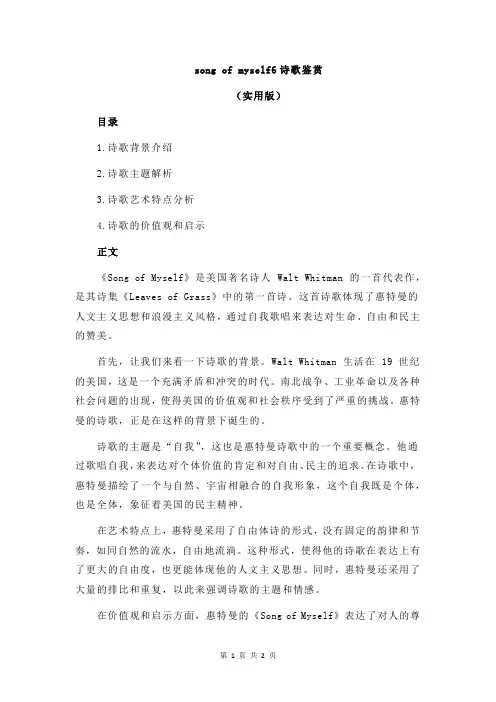
song of myself6诗歌鉴赏
(实用版)
目录
1.诗歌背景介绍
2.诗歌主题解析
3.诗歌艺术特点分析
4.诗歌的价值观和启示
正文
《Song of Myself》是美国著名诗人 Walt Whitman 的一首代表作,是其诗集《Leaves of Grass》中的第一首诗。
这首诗歌体现了惠特曼的人文主义思想和浪漫主义风格,通过自我歌唱来表达对生命、自由和民主的赞美。
首先,让我们来看一下诗歌的背景。
Walt Whitman 生活在 19 世纪的美国,这是一个充满矛盾和冲突的时代。
南北战争、工业革命以及各种社会问题的出现,使得美国的价值观和社会秩序受到了严重的挑战。
惠特曼的诗歌,正是在这样的背景下诞生的。
诗歌的主题是“自我”,这也是惠特曼诗歌中的一个重要概念。
他通过歌唱自我,来表达对个体价值的肯定和对自由、民主的追求。
在诗歌中,惠特曼描绘了一个与自然、宇宙相融合的自我形象,这个自我既是个体,也是全体,象征着美国的民主精神。
在艺术特点上,惠特曼采用了自由体诗的形式,没有固定的韵律和节奏,如同自然的流水,自由地流淌。
这种形式,使得他的诗歌在表达上有了更大的自由度,也更能体现他的人文主义思想。
同时,惠特曼还采用了大量的排比和重复,以此来强调诗歌的主题和情感。
在价值观和启示方面,惠特曼的《Song of Myself》表达了对人的尊
严和价值的肯定,对自由、民主的追求,以及对生命的热爱和尊重。
这些价值观,对于我们今天的社会,仍然有着重要的启示意义。
同时,他的诗歌也告诉我们,每个人都有自己的价值,都应该被尊重。

【自主阅读】1我自己的歌(之一)自学指导一、惠特曼的诗歌,往往由一组松散的句子构成,不仅没有严格的韵脚,而且也打破了一般的诗歌形式,开创了一种近乎口语的散文化的自由诗体。
阅读这首作品,可注意这种“自由”的特征:句子的排列长短交替,非常疏散,最短的句子十几个字,最长的句子多达近三十个字;另外,诗人使用的语言也平白如话,这种“自由”使得诗歌的展开,也“顺乎自然,保持原始的活力”。
二、虽然形式的自由,带来了散文化的风格,但散文化的诗歌并不等同于散文,大声诵读此诗,会发现其中暗藏的节奏。
这种节奏感的获得,很大程度上,来自诗人对特定句式的使用,比如“我承担的你也将承担”,“父母的父母也是在这里生下的,他们的父母也一样”,词汇、句式的重复、递进,使得自然之中包含了节奏。
三、此诗的主题是歌颂一种健康的、原始的生命活力,“我”在土壤、空气中成长,灵肉,这里的“我”不单指诗人自己,也包括了他人(“你”),甚至所有人(“父母的父母”),是一种理想人性的化身。
参考资料一、惠特曼式的自由诗体(李野光)惠特曼是诗歌艺术尤其诗歌形式发展史上一位大胆的探索者和创新者,他全面否定了以音节、重音和脚韵为基本要素的诗歌格律,而代之以一种崭新的艺术形式,即所谓惠特曼式的自由诗体。
惠特曼诗学的一条基本原理是:“诗的特性并不在于韵律或形式的均匀”,因为它所要写的“不是事物及其表象,而是它们之间的关系的精神”,何况宇宙万物多种多样,它们不需要机械的、外表的规律和统一。
他引用法国文艺批评家丹纳的观点指出:“一切独创性的艺术都是自动调节的,没有哪一种能从外部加以调节。
它具有自己的平衡能力,以自己的血液维持生命。
”尤其诗歌,惠特曼认为,“它的法则和领域永远不是外部的而是内部的”,因此它的节奏也只能从内部产生,在内部调整,而不能以某种形式从外部强加于它。
他的诗行参差不齐,但长者居多,而且要多长有多长,同时每一行自成独立的陈述,极少转行的现象。
它没有脚韵,不讲格律,只有一种由短语或单词构成的内部节奏。
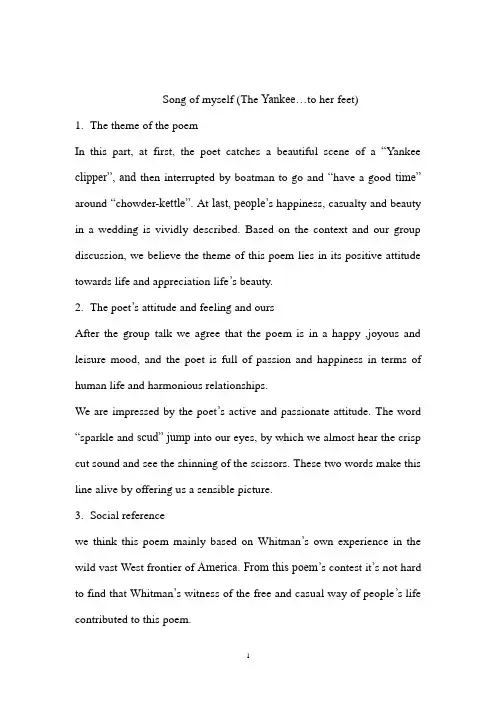
Song of myself (The Yankee…to her feet)1.The theme of the poemIn this part, at first, the poet catches a beautiful scene of a “Yankee clipper”, and then interrupted by boatman to go and “have a good time” around “chowder-kettle”. At last, people’s happiness, casualty and beauty in a wedding is vividly described. Based on the context and our group discussion, we believe the theme of this poem lies in its positive attitude towards life and appreciation life’s beauty.2.The poet’s attitude and feeling and oursAfter the group talk we agree that the poem is in a happy ,joyous and leisure mood, and the poet is full of passion and happiness in terms of human life and harmonious relationships.We are impressed by the poet’s active and passionate attitude. The word “sparkle and scud” jump into our eyes, by which we almost hear the crisp cut sound and see the shinning of the scissors. These two words make this line alive by offering us a sensible picture.3.Social referencewe think this poem mainly based on Whitman’s own experience in the wild vast West frontier of America. From this poem’s contest it’s not hard to find that Whitman’s witness of the free and casual way of people’s life contributed to this poem.nguageThis poem is written in bank verse, the unique form of Whitman’s poem. It’s free form pulsing the plain words make this poem easy to understand. Whitman also employs a factual tone, a straight forward way when he describes the “Yankee clipper”, the party, and people who are going to have a wedding.I heard a fly buzz---when I die---1. Theme of the poemThe poet described what I’ll go through “when I die”. The poet “heard a fly buzz”, wondering she is seeing God, flashing back what she had been through and gradually dying.2. Attitude and feelingIn term of facing death, the poet stays sober and calm and treats death as something trivial. A still and silent environment is created .we can feel this from “hear a buzz” and“breaths were gathering firm”. The poet dies without any company suggesting a lonely atmosphere.The line “The Eyes around---had wrung them dry ---And Breaths were gathering firm” impress me the most. It gives me detailed description on the poet’s death slowly and surely. The process from live to death seems being stretched, which made me terrified and sad in a way.3 RhythmThis poem has 4 stanzas and each stanza has 4 lines. The rhyme scheme is A BCB, with trimester and tetrameter iambic lines.4 languageThe poem is written in unique Emily Dickinson’s style: frequent use of dash, Capitalization and off-rhymes that could be found everywhere in the poem. The dash is the only punctuation used, which save time for readers to pause, feel and think. Capitalization obviously stressed the importance and feeling of the words like “Fly” “Heaves”“Keepsakes” and “Windows”. Onomatopoeia could also be found. The “buzz”is the sound of “a fly I heard when I died”. The poet employs religious language when she said “the King”, who is God. She also uses symbolic language. The fly is a symbol of her trivial death. And as she mentioned “my Keepsakes”, what she had been through in her whole life flash back in front of her eyes.。
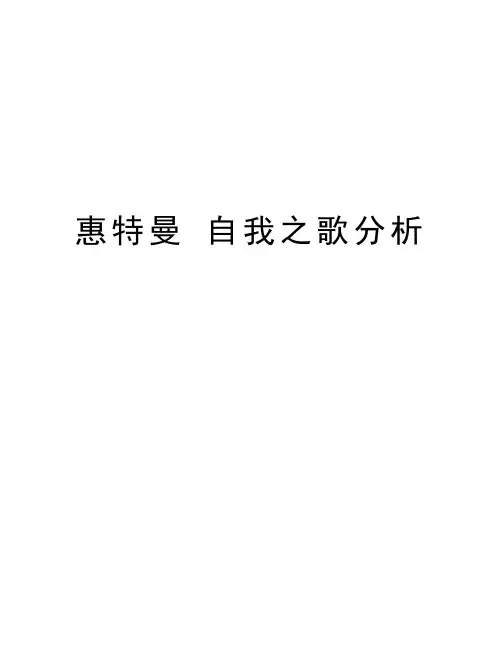
惠特曼自我之歌分析Song of myself (The Yankee…to her feet)1.The theme of the poemIn this part, at first, the poet catches a beautiful scene of a “Yankee clipper”, and then interrupted by boatman to go and “have a good time” around “chowder-kettle”. At last, people’s happiness, casualty and beauty in a wedding is vividly described. Based on the context and our group discussion, we believe the theme of this poem lies in its positive attitude towards life and appreciation life’s beauty.2.The poet’s attitude and feeling and oursAfter the group talk we agree that the poem is in a happy ,joyous and leisure mood, and the poet is full of passion and happiness in terms of human life and harmonious relationships.We are impressed by the poet’s active and passionate attitude. The word “sparkle and scud” jump into our eyes, by which we almost hear the crisp cut sound and see the shinning of the scissors. These two words make this line alive by offering us a sensible picture.3.Social referencewe think this poem mainly based on Whitman’s own experience in the wild vast West frontier of America. From this poem’s contest it’s not hard to find that Whitman’s witness of the free and casual way of people’s life contributed to this poem.nguageThis poem is written in bank verse, the unique form of Whitman’s poem. It’s free form pulsing the plain words make this poem easy to understand. Whitman also employs a factual tone, a straight forward way when he describes the “Yankee clipper”, the party, and people who are going to have a wedding.I heard a fly buzz---when I die---1. Theme of the poemThe poet described what I’ll go through “when I die”. The poet “heard a fly buzz”, wondering she is seeing God, flashing back what she had been through and gradually dying.2. Attitude and feelingIn term of facing death, the poet stays sober and calm and treats death as something trivial. A still and silent environment is created .we can feel this from “hear a buzz” and“breaths were gathering firm”. The poet dies without any company suggesting a lonely atmosphere.The line “The Eyes around---had wrung them dry ---And Breaths were gathering firm” impress me the most. It gives me detailed description on the poet’s death slowly and surely. The process from live to death seems being stretched, which made me terrified and sad in a way.3 RhythmThis poem has 4 stanzas and each stanza has 4 lines. The rhyme scheme is A BCB, with trimester and tetrameter iambic lines.4 languageThe poem is written in unique Emily Dickinson’s style: frequent use of dash, Capitalization and off-rhymes that could be found everywhere in the poem. The dash is the only punctuation used, which save time for readers to pause, feel and think. Capitalization obviously stressed the importance and feeling of the words like “Fly” “Heaves”“Keepsakes” and “Windows”. Onomatopoeia could also be found. The “buzz” is the sound of “a fly I heard when I died”. The poet employs religious language when she said “the King”, who is God. She also uses symbolic language. The fly is a symbol of her trivial death. And as she mentioned “my Keepsakes”, what she had been through in her whole life flash back in front of her eyes.。
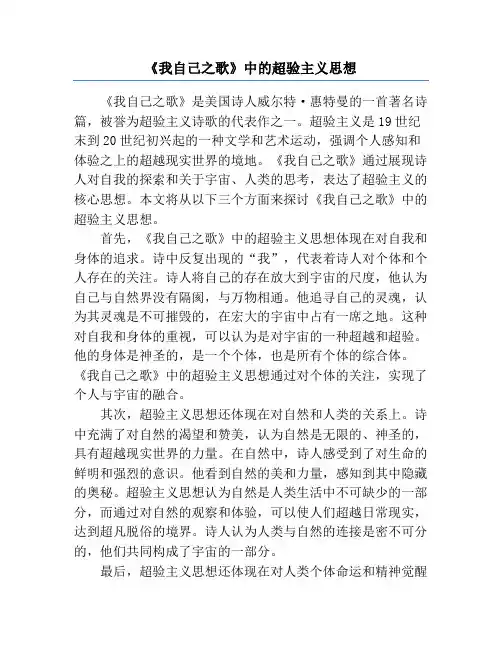
《我自己之歌》中的超验主义思想《我自己之歌》是美国诗人威尔特·惠特曼的一首著名诗篇,被誉为超验主义诗歌的代表作之一。
超验主义是19世纪末到20世纪初兴起的一种文学和艺术运动,强调个人感知和体验之上的超越现实世界的境地。
《我自己之歌》通过展现诗人对自我的探索和关于宇宙、人类的思考,表达了超验主义的核心思想。
本文将从以下三个方面来探讨《我自己之歌》中的超验主义思想。
首先,《我自己之歌》中的超验主义思想体现在对自我和身体的追求。
诗中反复出现的“我”,代表着诗人对个体和个人存在的关注。
诗人将自己的存在放大到宇宙的尺度,他认为自己与自然界没有隔阂,与万物相通。
他追寻自己的灵魂,认为其灵魂是不可摧毁的,在宏大的宇宙中占有一席之地。
这种对自我和身体的重视,可以认为是对宇宙的一种超越和超验。
他的身体是神圣的,是一个个体,也是所有个体的综合体。
《我自己之歌》中的超验主义思想通过对个体的关注,实现了个人与宇宙的融合。
其次,超验主义思想还体现在对自然和人类的关系上。
诗中充满了对自然的渴望和赞美,认为自然是无限的、神圣的,具有超越现实世界的力量。
在自然中,诗人感受到了对生命的鲜明和强烈的意识。
他看到自然的美和力量,感知到其中隐藏的奥秘。
超验主义思想认为自然是人类生活中不可缺少的一部分,而通过对自然的观察和体验,可以使人们超越日常现实,达到超凡脱俗的境界。
诗人认为人类与自然的连接是密不可分的,他们共同构成了宇宙的一部分。
最后,超验主义思想还体现在对人类个体命运和精神觉醒的探索中。
诗中提到了各种不同个体的经历,展示了人类的多样性和普世性。
这些个体有各自的独立生活和意识,但又与其他个体相互联结。
诗人通过描述他自己以及其他人的经历,探索了人类存在的本质和个体意识的力量。
他力图超越身体的束缚,追求心灵和灵魂的解放。
超验主义思想认为个体的觉醒和灵性的追求是实现超凡脱俗的关键,超越个体的困扰和拘束,达到灵魂的解放和上升。
总之,《我自己之歌》中的超验主义思想体现在对自我和身体的追求、对自然和人类的关系的感知,以及对个体命运和精神觉醒的追求上。
![评析《自我之歌》的文学价值和社会价值[权威资料]](https://uimg.taocdn.com/59b6f4b6dc3383c4bb4cf7ec4afe04a1b071b0bc.webp)
评析《自我之歌》的文学价值和社会价值摘要:美国著名诗人惠特曼的代表作《自我之歌》被收纳在他的诗歌集《草叶集》中,是十分具有影响力的作品。
从诗歌的体裁、形式到中心思想、表达方式都别具一格,从思想和形式上突破传统诗歌的创作。
本文根据诗人所生活的历史背景联系诗歌内容,对《自我之歌》进行简要的赏析,并对它的文学价值和社会价值做出评析。
关键字:自由之歌文学价值社会价值民主一、《自我之歌》诗人介绍及写作背景(一)作者简介惠特曼全名沃尔特・惠特曼,是生活在17世纪的美国著名诗人,他是美国民主主义者,也是革新派代表,所以他的诗歌大都赋有民主主义色彩,后人称他的诗歌体为自由体,他的诗歌形式突破了传统诗歌形式的束缚,代表作是《草叶集》,这本诗歌集在1855年出版,并多次更新和再出版,惠特曼许多著名的新作品都收纳在其中,从第一版的12首诗歌发表到最后一次出版的383首诗歌,共经历了9次更新,所以《草叶集》是惠特曼的毕生心血,其中最长的最有影响力的一首就是《自我之歌》。
惠特曼生活的年代是美国建国初期,政局不稳定,他经历了美国民主党内部的分裂、奴隶拍卖、黑白人在美国的不公平待遇、林肯被刺杀和南北战争等重大事件,他从小喜欢民主思想家潘恩的作品,喜欢自由和艺术,长期从事报纸的撰稿工作,有时也进行政治演讲,他从小不寻常的成长经历使他成为一个民主主义者,维护民主党。
当他亲眼目睹奴隶拍卖在美国大陆上普遍发生自己却无能为力时,他开始投身于文学创作和写诗歌,提倡自由和民主;在林肯被刺杀时和被刺杀20周年纪念日时,分别发表了《草叶集》和《献给那个被钉在十字架上的人》;南北战争期间,主动担任战时护士的角色,尽心尽力,甚至为了照顾病人损害了自己的健康,体现了他的人道主义本色,战时仍然坚持抄写诗歌和学习,两年的时间里,他结识了近十万士兵并在战后保持联系,这段经历也为他之后诗歌创作进入新的阶段奠定了基础。
(二)写作背景惠特曼创作《自我之歌》的时候,美国刚刚摆脱了英国的禁锢,获得了独立,美国开始独立发展经济,但是从某些方面来看还是依赖着英国,比如文化方面还是没有自己的思想和特色文化,他生活在美国,亲眼目睹和感受着美国的独立、完善和发展。
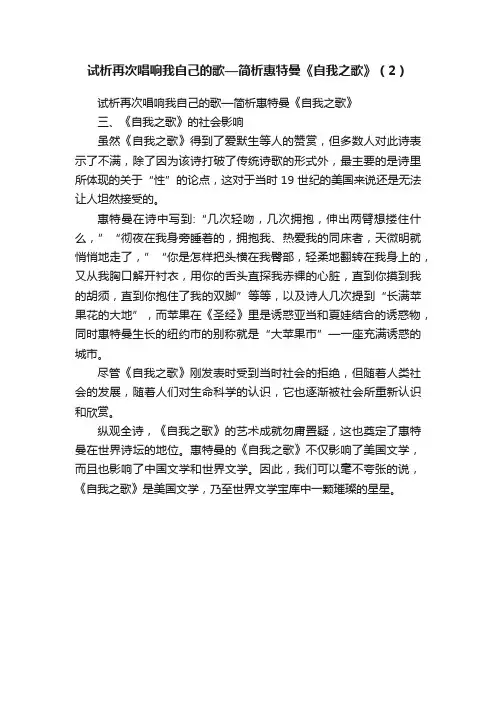
试析再次唱响我自己的歌—简析惠特曼《自我之歌》(2)
试析再次唱响我自己的歌—简析惠特曼《自我之歌》
三、《自我之歌》的社会影响
虽然《自我之歌》得到了爱默生等人的赞赏,但多数人对此诗表示了不满,除了因为该诗打破了传统诗歌的形式外,最主要的是诗里所体现的关于“性”的论点,这对于当时19世纪的美国来说还是无法让人坦然接受的。
惠特曼在诗中写到:“几次轻吻,几次拥抱,伸出两臂想搂住什么,”“彻夜在我身旁睡着的,拥抱我、热爱我的同床者,天微明就悄悄地走了,”“你是怎样把头横在我臀部,轻柔地翻转在我身上的,又从我胸口解开衬衣,用你的舌头直探我赤裸的心脏,直到你摸到我的胡须,直到你抱住了我的双脚”等等,以及诗人几次提到“长满苹果花的大地”,而苹果在《圣经》里是诱惑亚当和夏娃结合的诱惑物,同时惠特曼生长的纽约市的别称就是“大苹果市”—一座充满诱惑的城市。
尽管《自我之歌》刚发表时受到当时社会的拒绝,但随着人类社会的发展,随着人们对生命科学的认识,它也逐渐被社会所重新认识和欣赏。
纵观全诗,《自我之歌》的艺术成就勿庸置疑,这也奠定了惠特曼在世界诗坛的地位。
惠特曼的《自我之歌》不仅影响了美国文学,而且也影响了中国文学和世界文学。
因此,我们可以毫不夸张的说,《自我之歌》是美国文学,乃至世界文学宝库中一颗璀璨的星星。

惠特曼自我之歌分析沃尔特·惠特曼是美国诗歌史上的重要人物,其代表作《自我之歌》更是具有深远的影响力。
这部作品展现了惠特曼独特的诗歌风格和深刻的思想内涵。
在《自我之歌》中,惠特曼以一种极为开放和包容的姿态来描绘自我。
他所定义的“自我”并非狭隘的个体,而是涵盖了世间万物。
这种对自我的广泛定义,打破了传统诗歌中对个体的有限描绘,使得诗歌的视野变得无比广阔。
惠特曼将自我与自然、人类社会以及宇宙紧密相连,他在诗中写道:“我赞美我自己,歌唱我自己,/我所讲的一切,将对你们也一样适合,/因为属于我的每一个原子,也同样属于你。
”这表明他认为每个人的本质都是相通的,自我并非孤立存在,而是与周围的世界相互交融。
惠特曼在诗歌中展现了对多样性的尊重和赞美。
他描写了各种不同的人物、场景和经历,无论是劳动者、奴隶,还是不同肤色、不同种族的人们,都在他的诗中找到了一席之地。
这种对多样性的包容,反映了他对人类社会平等与和谐的向往。
他通过对不同个体的描述,强调了每个人都有其独特的价值和意义,都应当被尊重和认可。
诗歌的语言风格也是其一大特色。
惠特曼摒弃了传统诗歌严格的格律和韵律,采用了自由奔放的长句和短句相结合的形式。
这种语言形式使他能够更加自由地表达内心的情感和思想,不受传统诗歌形式的束缚。
例如:“我辽阔博大,我包罗万象。
” 这样简洁而有力的语句,直接传达出他对自我的强大认知和自信。
此外,《自我之歌》中还充满了强烈的生命意识。
惠特曼对生命的赞美贯穿始终,他认为生命是一种神奇而宝贵的存在,无论经历多少挫折和困难,生命都应当被珍视和热爱。
他在诗中描绘了大自然的生机与活力,以及人类生活中的喜怒哀乐,展现了生命的丰富多彩和顽强不屈。
从主题上来看,惠特曼通过《自我之歌》探讨了自我认同、个体与社会的关系以及生命的意义等重要议题。
他呼吁人们要勇敢地认识自己、接纳自己,同时也要关注他人,共同构建一个和谐、包容的社会。
他对生命的积极态度,鼓励着人们在面对生活的挑战时保持乐观和坚定。
Song of Myself (自我之歌) --------Walt Whitman (realism)I celebrate myself,and sing myself, (Self includes everything and everyone in the universe)And what I assume you shall assume,(I and you stands for new Americans withyou. (embody the unity of youit emphasize the closely connection of you and I),(Loafe: =loaf 闲逛Emphasize the unity of body and soul)(Grass stands for我赞美我自己,歌唱我自己,我所讲的一切,将对你们也一样适合,因为属于我的每一个原子,也同样属于你。
我闲游,邀请我的灵魂一起,我俯首下视,悠闲地观察一片夏天的草叶。
My tongue,every atom of my blood,form‘d from this soil,this air,Born ere of parents born here from parents the same,and their parents the same,I,now thirty seven years old in perfect health begin,Creeds and schools in abeyance,(a state of disuse or suspension 归属待定尤)Retiring back a while sufficed at what they are,but never forgotten.I harbor (怀有) for good or bad,I permit to speak at every hazard. 随便地,Nature without check with(与….相符)original energy.我的舌,我的血液中的每个原子,都是由这泥土这空气构成,我生在这里,我的父母生在这里,他们的父母也生在这里,我如今三十七岁,身体完全健康,开始歌唱,希望不停地唱下去,直到死亡。
简析惠特曼《自我之歌》沃尔特??惠特曼(Walt Whitman, 1819-1892)是一位世界著名的美国民主主义诗人,是美国文学史上的革新派代表。
他创作的诗歌体被后人称为自由体,因为惠特曼认为民主之音不能被传统的诗歌形式所束缚。
1855年他首次出版了他的著名诗集《草叶集》。
《草叶集》第一版问世时,共收诗12首,最后出第9版时共收诗383首,其中最长的一首《自我之歌》共1 336行。
这首诗的内容几乎包括了作者毕生的主要思想,是作者最重要的诗歌之一。
惠特曼诗歌的艺术风格和传统的诗体大不相同。
他一生热爱意大利歌剧、演讲术和大海的滔滔浪声。
西方学者指出这是惠特曼诗歌的音律的主要来源。
他的诗歌从语言和题材上深刻地影响了20世纪的美国诗歌。
《草叶集》问世后,评论家们议论纷纷,毁誉参半,争论焦点就是《自我之歌》。
尽管当时美国文坛的盟主爱默生独具慧眼,读完诗集以后赞赏有加,并写信给惠特曼,称赞“它是美国出版过的最出色的,富有才智和智慧的诗篇”,但是由于其异于常规的风格而受到绝大多数作家和批评家包括费罗、罗威尔的猛烈攻击。
惠特曼写诗的初衷是希望为人民大众所接受,遗憾的是却被大多数公众所忽视。
一、一首抒情诗史惠特曼在《我自己的歌》一诗的开头写道:我赞美我自己,歌唱我自己,我承担的你也将承担,因为属于我的每一个原子也同样属于你。
在这首诗的最后一节,诗人又是这样写的:如果你一时找不到我,请不要灰心丧气,一处找不到再到别处去找,我总在某个地方等候着你。
全诗以“我”开篇,又以“你”结尾,这种写法有其独特的艺术魅力。
纵观全诗,尽管这个“我”总是以叙事者的身份在诗中占据主导地位,但是这个“你”却始论文联盟整理终伴随着“我”歌唱着《我自己的歌》。
在惠特曼之前,从未有哪一个美国诗人像他这样如此重视过读者的作用。
与19世纪许多浪漫派诗人一样,惠特曼也怀着一种强烈的自我意识,在诗歌创作中用第一人称“我”为主人公,抒发诗人个人的情感。
惠特曼是美国著名的诗人,擅长运用含蓄委婉的语言来抒发自己的情感、展现作品的主题。
《自己之歌》是惠特曼创作的一首小诗。
在这首诗歌中,诗人精心撷取了多个意象,表达了对自己的赞美之情。
从表面上看,诗人似乎是在赞美自己;实际上,他是想通过诗中的“自己”来展现另一个不同于自己的“大我”,借此讴歌创造新世界的美国民众。
接下来,笔者就谈谈这首诗的艺术特色。
一、意象丰富在诗歌中,“我”反复出现。
诗人似乎只是在写“我”。
仔细品读,我们就会发现他写的其实并非自己。
“我看出我是和片麻石、水果、谷粒、可食的菜根教材解析JIAO JIE XI教析JIE XI混合在一起,并且全身装饰着飞鸟和走兽,虽然有很好的理由远离了过去的一切,但需要的时候我又可以将任何东西召来。
”为了表现诗歌的主题,诗人选取了大量的事物作为诗歌的意象,包括“片麻石”“谷粒”“草叶”“蚂蚁”“沙”“黑莓”“母牛”“小鼠”等,上述意象都有一个共同的特征,那就是它们都极其平凡,都是生活中非常常见的事物,一般难以引起人们的注意。
“我”和片麻石、煤、藓苔等平凡事物“混合在一起”,说明“我”是平凡的;“装饰着飞鸟和走兽”,说明“我”是追求自由的。
诗人在诗作中将“我”与这些平凡的事物放在同等的位置上,揭示了一个道理:自己与普通的事物之间并无区别,都是“造物主的一种精工的制作”,“我”并不比世上其他的事物要高贵,而其他的事物也不能超越“我”。
在诗人看来,世间的万物都是平等的,并无高低贵贱之分。
这充分展现了诗人所具有的民主、平等的意识。
“但需要的时候我又可以将任何东西召来。
”“我”虽然尊重世间的万物,却也会根据自己的需求对其进行改造和创新。
诗人的这种观点非常新颖,展现了19世纪美国人民的精神面貌,赞美了他们努力拼搏、开拓创新的精神。
二、手法独特惠特曼认为诗的内容是模糊的,主张用含蓄、迂回的方式将读者带入特殊的意境之中。
在《自己之歌》中,诗人运用了象征、对比等手法,增强了诗歌的表达效果。
试析再次唱响我自己的歌—简析惠特曼《自我之歌》关键词:惠特曼抒情诗史生命之歌论文摘要:《自我之歌》是惠特曼最有影响力的作品。
文章从诗歌体裁,主题思想和社会影响三个方面分析了《自我之歌》,肯定了《自我之歌》的文学价值和社会价值。
沃尔特·惠特曼(Walt Whitman, 1819-1892)是一位世界著名的美国民主主义诗人,是美国文学史上的革新派代表。
他创作的诗歌体被后人称为自由体,因为惠特曼认为民主之音不能被传统的诗歌形式所束缚。
1855年他首次出版了他的著名诗集《草叶集》。
《草叶集》第一版问世时,共收诗12首,最后出第9版时共收诗383首,其中最长的一首《自我之歌》共1 336行。
这首诗的内容几乎包括了作者毕生的主要思想,是作者最重要的诗歌之一。
惠特曼诗歌的风格和传统的诗体大不相同。
他一生热爱意大利歌剧、演讲术和大海的滔滔浪声。
西方学者指出这是惠特曼诗歌的音律的主要来源。
他的诗歌从语言和题材上深刻地影响了20世纪的美国诗歌。
《草叶集》问世后,评论家们议论纷纷,毁誉参半,争论焦点就是《自我之歌》。
尽管当时美国文坛的盟主爱默生独具慧眼,读完诗集以后赞赏有加,并写信给惠特曼,称赞“它是美国出版过的最出色的,富有才智和智慧的诗篇”,但是由于其异于常规的风格而受到绝大多数作家和批评家包括费罗、罗威尔的猛烈攻击。
惠特曼写诗的初衷是希望为人民大众所接受,遗憾的是却被大多数公众所忽视。
一、一首抒情诗史惠特曼在《我自己的歌》一诗的开头写道: 我赞美我自己,歌唱我自己,我承担的你也将承担,因为属于我的每一个原子也同样属于你。
在这首诗的最后一节,诗人又是这样写的: 如果你一时找不到我,请不要灰心丧气,一处找不到再到别处去找,我总在某个地方等候着你。
全诗以“我”开篇,又以“你”结尾,这种写法有其独特的艺术魅力。
纵观全诗,尽管这个“我”总是以叙事者的身份在诗中占据主导地位,但是这个“你”却始终伴随着“我”歌唱着《我自己的歌》。
《自己之歌》是美国19世纪杰出的民主诗人华尔特·惠特曼的作品。
诗人认为诗是一种内在的、捉摸不着的东西,他强调要以含蓄、迂回的暗示手法将读者带入主题或思想的氛围。
此诗也正体现了这一特点。
英文版本I celebrate myself, and sing myself,all I say to you, as appropriate, for every atom belonging to me,also belongs to you.And invite my soul with me around,I bow down, leisurely observation of a piece of summer grass.My tongue, every atom of my blood, are from this earth, the air,I grow up here, my parents grow here, their parents also grow here,I am now thirty-seven years old, the body is healthy,hope to continue to keep on singing till death.Dogma and school in abeyance,step back, satisfied now they already gave me everything,but never put them all forgotten,whether it is good or evil, I will be free of, no scruples,with a primitive energy natural.汉语译文我赞美我自己,歌唱我自己,我所讲的一切,将对你们也一样适合,因为属于我的每一个原子,也同样属于你。
song of myself6诗歌鉴赏《我自己之歌》是美国著名诗人沃尔特·惠特曼的代表作之一。
这首诗描绘了惠特曼对自然、人生和个体自由的独特见解,以及他对人类共同体的思考。
同时,通过对自己的描写与对他人的认同,展示了诗人对个体与社会的关系的思考和思想。
本文将以鉴赏的形式,深入解读《我自己之歌》的内容、意象以及语言艺术。
《我自己之歌》是一首自由体诗,由52个未命名的单元构成,每一个单元都有自己独特的节奏和意象。
首先,着重介绍了作者自己,他认为自己是一个包含宇宙万象的个体。
在整首诗中,他通过自然、人生和他人来展示他的存在感和个体的独特价值。
诗中自由自在的语言通过生动而深邃的意象扣住人们的情绪。
作者利用各种象征和比喻手法,将自然界的景物与人类的情感、意义相联系,使诗歌充满了诗情画意。
比如,“浩瀚无垠的原野”代表了个体的无限可能性和内在力量,而“细小的草叶”和“脚下的土壤”则象征了个体与自然的紧密联系,传递出生命的宝贵和意义。
此外,诗中多次出现的“我”,不仅是诗人自我表达的方式,也是他对人性的研究和探索。
诗人认为每个个体都是独特的存在,具有无尽的可能性和内在的价值。
他通过自己的身体和心灵来描绘自我,并将之与他人联系起来,表达出对所有个体的认同和关爱。
作者写道:“我(即普通人)给你的名字再早一秒钟,你可能就不是你了。
”这句话象征着作者对每个个体的尊重和珍视,呼吁人们不要放弃自己的独特性和真实性。
除了对个体自身的表达,诗中还融入了对社会和人类命运的思考。
诗人以自然为参照,对社会不公、人际关系的种种问题进行了批判和反思。
他认为个体的解放与自由不仅仅是一场个人的追求,而是整个人类社会进步的需要。
他写道:“我重新看到那些曾经破碎的心连成一体,感受着破碎的柔软但还是愉快的人。
”这句话表达了作者对人类团结和和谐的向往和期望。
值得一提的是,诗中还包含了许多宗教意象和对神秘力量的追求。
作者将自然界的景物与宇宙的起源相连,通过对大自然的称颂和赞美,表达了他对神秘力量和生命意义的思考。
Song of myself (The Yankee…to her feet)
1.The theme of the poem
In this part, at first, the poet catches a beautiful scene of a “Yankee clipper”, and then interrupted by boatman to go and “have a good time” around “chowder-kettle”. At last, people’s happiness, casualty and beauty in a wedding is vividly described. Based on the context and our group discussion, we believe the theme of this poem lies in its positive attitude towards life and appreciation life’s beauty.
2.The poet’s attitude and feeling and ours
After the group talk we agree that the poem is in a happy ,joyous and leisure mood, and the poet is full of passion and happiness in terms of human life and harmonious relationships.
We are impressed by the poet’s active and passionate attitude. The word “sparkle and scud” jump into our eyes, by which we almost hear the crisp cut sound and see the shinning of the scissors. These two words make this line alive by offering us a sensible picture.
3.Social reference
we think this poem mainly based on Whitman’s own experience in the wild vast West frontier of America. From this poem’s contest it’s not hard to find that Whitman’s witness of the free and casual way of people’s life contributed to this poem.
nguage
This poem is written in bank verse, the unique form of Whitman’s poem. It’s free form pulsing the plain words make this poem easy to understand. Whitman also employs a factual tone, a straight forward way when he describes the “Yankee clipper”, the party, and people who are going to have a wedding.
I heard a fly buzz---when I die---
1. Theme of the poem
The poet described what I’ll go through “when I die”. The poet “heard a fly buzz”, wondering she is seeing God, flashing back what she had been through and gradually dying.
2. Attitude and feeling
In term of facing death, the poet stays sober and calm and treats death as something trivial. A still and silent environment is created .we can feel this from “hear a buzz” and“breaths were gathering firm”. The poet dies without any company suggesting a lonely atmosphere.
The line “The Eyes around---had wrung them dry ---And Breaths were gathering firm” impress me the most. It gives me detailed description on the poet’s death slowly and surely. The process from live to death seems being stretched, which made me terrified and sad in a way.
3 Rhythm
This poem has 4 stanzas and each stanza has 4 lines. The rhyme scheme is A BCB, with trimester and tetrameter iambic lines.
4 language
The poem is written in unique Emily Dickinson’s style: frequent use of dash, Capitalization and off-rhymes that could be found everywhere in the poem. The dash is the only punctuation used, which save time for readers to pause, feel and think. Capitalization obviously stressed the importance and feeling of the words like “Fly” “Heaves”“Keepsakes” and “Windows”. Onomatopoeia could also be found. The “buzz”is the sound of “a fly I heard when I died”. The poet employs religious language when she said “the King”, who is God. She also uses symbolic language. The fly is a symbol of her trivial death. And as she mentioned “my Keepsakes”, what she had been through in her whole life flash back in front of her eyes.。